In the FPS Atomic Heart, players find themselves in an alternate reality where they live alongside robots in an “advanced” USSR, until the bots rise up against their creators. The game itself has some technological hits and misses, but the graphics and art are great, and overall, it offers plenty of entertainment value. However, controversy has arisen surrounding the game’s publisher, Mundfish, with accusations that it is collecting user data of those in Russia and giving it to the Russian security agency.
If you liked BioShock, Stalker, Metro Exodus, or maybe Far Cry, you’re going to enjoy Atomic Heart. And if you’ve played Cyberpunk 2077, you’ll recognize some voices.
Atomic Heart is a slick FPS built on Unreal Engine 4 and 5, and employs Nvidia’s DLSS 3.0 for those lucky enough to have an RTX 40 series AIB, but AMD and older-gen Nvidia AIBs play well too, just not quite as pretty or at as high FPS.
Whereas Far Cry depicts postwar US, and FC5 Cuba, Atomic Heart, like Stalker, depicts postwar USSR—except in Atomic Heart, modern-day USSR is the most advanced country in the world. Yet, like the other games mentioned, there are plenty of throwbacks and references to pre-1970s. It is a fast-paced, interesting, and challenging game that will give you hours and hours of entertainment and four dramatically different levels to try.
The hero (you) is Comrade Major Nechaev, who is referred to as P-3 (the code name “P-3”—as in plutonium, the third discovered radioactive element—was assigned to Nechaev after he ended up, severely wounded, in professor Sechenov’s lab). He is the typical reluctant hero—pensive and gloomy, and a bit whiny at times, which he makes up for with caustic remarks. But the dialogue is really stinted and childish. I suspect that is because it’s probably a translation. Also, the actor just doesn’t seem to have the right emphasis at the right time, as if he is overacting, trying too hard to make it scary or exciting, which fails. You’d almost be better off killing his voice and just using the subtitles. Also, the voice doesn’t match the physique of the hero at all.
In the monumental places that have not been damaged yet, although other reviewers have said the ray tracing has been pulled, the reflection maps are brilliant—really freaking brilliant. In one lobby, I was looking at the floor, which was marble and showing all kinds of reflections from everywhere. I got so disoriented that I had to look up at the ceiling to get a reference point—how’s that for immersive! The use of ray tracing seems a bit inconsistent, and in many scenes, there is none, but rather good surface maps, nonetheless. The developers need to spend more time understanding refractive indexes; some of the RT is over amp’d.
Although it has an open world, it is a constrained world with the usual maze-like tunnels and rooms. There’s no map, but there is a destination and direction pointer, so although you seldom know where the hell you are, you do know where to go.
Early in the game, you get a left-hand magic polymer glove that has five 6cm-long tentacles that you can invoke with the V key. This prosthesis is really handy, and you can use it to scan rooms and find valuable junk, shoot electricity at attacking robots, and engage with an upgrading sexy bot enhancer.
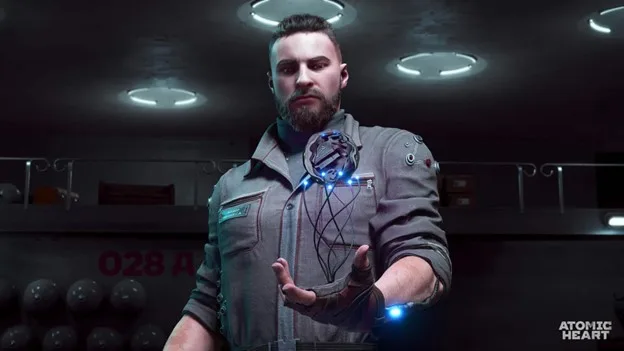
The main conceit of the story is that in the 1940s just as the WWII was getting underway, Professor Dimitry Sechenov discovered a unique polymer, which he called assimilative adaptation—the precursor to what today would be nanobots, but gooey. The substance can embed itself in the human body (presumably other creatures as well), which enables the attachment of the hand prosthesis. Its original intention was to control the many—way, way many—robots that Professor Sechenov started churning out. You’ll learn to hate those robots, with only one or two friendly or good ones among them (that I’ve found so far). The robots are pure eye candy, just fun to look at and watch.
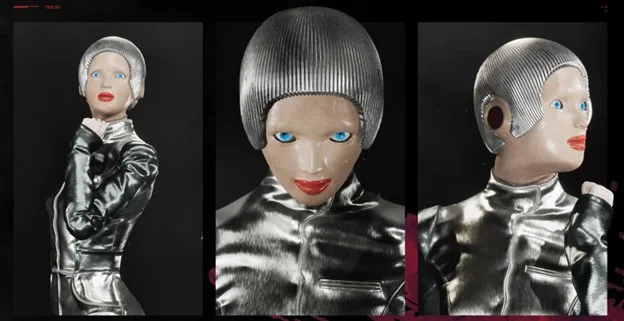
In the late 1940s, after having defeated the Nazis and Americans, the USSR, under Professor Sechenov’s direction, launches the Kolletkic 1.0 system, which provides robot assistants for almost every task—and judging by the anatomically correct shapes of some of the robots, maybe all tasks.
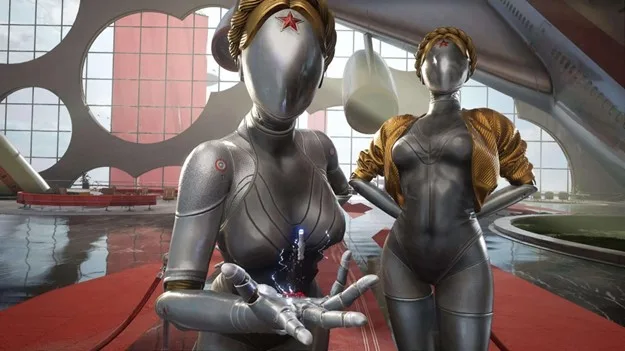
The game has some of the most imaginative and creative models I’ve seen in a long time, the art in the game is just fantastic. You can see some of the world, characters, and weapons here.
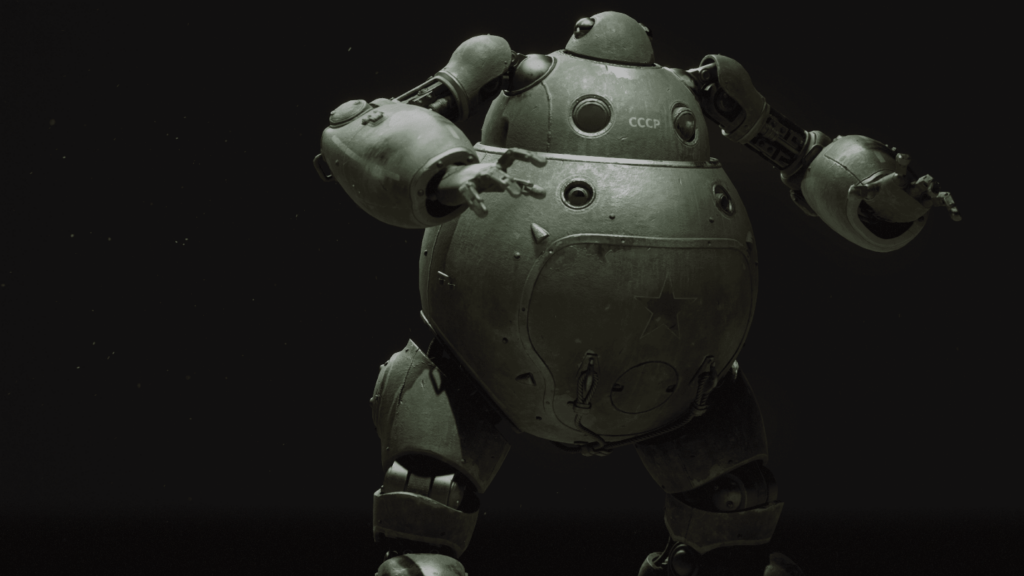
Anyone who has been conscious during 1990 knows what happened to the USSR and how bad life was in Russia, East Germany, and other satellite states. Therefore, the game’s premise is a joke, and even the side remarks by P-3 Comrade Major Nechaev makes that obvious.
Along the way, P-3 meets Baba-Zina (Баба-Зина), known as Grandma Zinaida Muravyova, and if she doesn’t convince you it’s tongue-in-cheek about USSR greatness, you need a binge session of the Road Runner to get your sense of humor back.
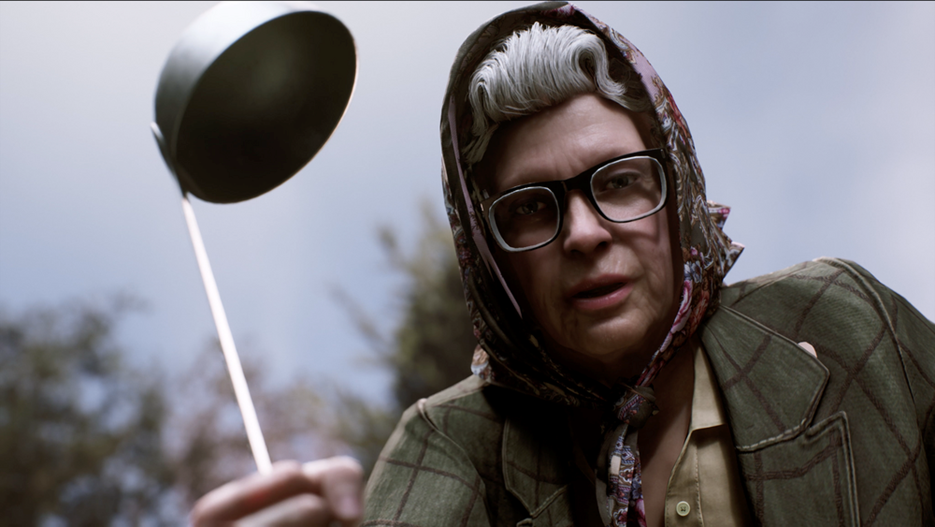
Because of the USSR theme, the alternate future where the USSR develops robotics to defeat Nazi Germany and put an end to WWII, some people have suggested the developer, Mundfish, has accepted funds from Russian authorities in the development of Atomic Heart. As a result, the game has been highly politicized.
The Russian connection
According to its website, Mundfish is a Cyprus-based international team of developers from countries including Poland, Ukraine, Austria, Georgia, Israel, Armenia, UAE, Serbia, and Cyprus.
But people on twitter kept asking Mundfish’s Twitter account about the company’s backers and location.To this, the reply was: “Guys, we have noted the questions surrounding where we, at Mundfish, stand. We want to assure you that Mundfish is a developer and studio with a global team focused on an innovative game and is undeniably a pro-peace organization against violence against people.”
After a couple of additional comments in a thread to their own tweet, they posted: “We do not comment on politics or religion. Rest assured; we are a global team focused on getting Atomic Heart into the hands of gamers everywhere” and “We do not, and will not, condone contributors or spammers with offensive, hateful, discriminatory, violent, or threatening language or content.”
But then, the question was exacerbated by a translation from ain.capital that was on Mundfish’s company store about its privacy policy, which said, “Mundfish collects users’ data and may provide it to Russian state authorities.”
Here is what Olha Karpenko at ain.capital published in late January under the headline “Russian developers of Atomic Heart collect gamers’ data for the FSB via its website.”
In the story with the scandalous Russian studio Mundfish, a developer of the Atomic Heart game, some new fascinating details have become known. According to the privacy policy on the company’s store website, Mundfish collects users’ data and may provide it to Russian state authorities, in particular, the FSB.
Quick overview of what is wrong with Atomic Heart
- Atomic Heart is positioned by the developers as BioShock-like Soviet shooter.
- The game is developed by Mundfish studio, which claims to be international with an office in Cyprus, but it is Russian in fact.
- It is sponsored by Russian investors, including an ex-Gazprom top manager with close ties to Russian oligarch Oleg Deripaska and the sanctioned VTB bank.
- Therefore, it’s no wonder that Mundfish studio never commented on the war in Ukraine and didn’t condemn Russia either. In a recent tweet, developers stated that they “do not comment on politics”
The privacy policy published on the studio’s website directly refers to the collection of user data, and the possible transfer of this data to Russian state authorities, in particular, the tax office and FSB.”
“The document,” says ain.capital (copied presumably from Mundfish and presented in ain.capital’s article), “is available only in Russian and is not available on the English-language version of the store.”
Mundfish’s statement omits the detail that its team was originally from Moscow, and that Russian media continue to describe the studio as Russian in articles about the game. Atomic Heart is not a Russian game. Mundfish was recently forced to deny claims it was harvesting data for Russian authorities.
Mundfish responded to shut down any potential unrest it could cause. “Our game and website DO NOT collect any information or data. The website’s privacy statement is outdated and wrong and should have been removed years ago. We have shut down the shop to assure our fans of the integrity of our studio and products. We apologize for any confusion on this matter,” Mundfish told GamesRadar.
What do we think?
I am not losing any sleep worrying about some clerk or data harvesting bot in bureaucratic Russia knowing that I am playing this game. Also, when you play the game, you quickly learn it ridicules the Soviet Union.
Since the ain.capital’s article, Mundfish denied the data collection accusations and offered the explanation above to GamesRadar.
Atomic Heart is a fun game, with great graphics, terrific and novel art, very good mechanics, and one or two problems. When I got my first upgrade, SMOK, the UI did not line up with my screen res (5120 × 1440, driven by an RTX 4090 (528.49 driver), with an i9-12900K at 3.2 GHz, running Win 11 Pro from a big, fat NVMe SSD), and I thought the game had crashed. When I reduced the resolution and put it in windowed mode, I discovered the Tab button in the lower right corner that was hidden.
The other issue I have is the FOV is too tight, and the setup control is joke—Max, High, Off. With a wide screen, I want to move things further away so I can see more of the room and who might be coming at me. And in battle, I totally lose sight of the enemy. I found Off to be the most comfortable but still not what I want. Next step is to see if I can find an .INI file to tweak.
There is also annoying inconvenience in movable objects—some boxes are movable, others are not—and almost no depth on the control functions. For example, to exit the polymer, you press L-Shift. But nothing happens because, as you find from trial and error, you must then press F (action button) after L-Shift. The UI, in general, is rather rough, lacking some niceties, and there is no help at all. However, helpful instruction windows pop up when it’s time to learn a new operation—if only they were stored somewhere so you could go back and refer to them.
So you won’t rush through this game—and you shouldn’t, in fact—you are advised not to in the beginning. Take you time, look around (after you’ve delt with the robots). Of course, it has a boss fight at the end, which I’m not looking forward to. I usually quit a game at the boss fight, it’s such as waste of time and repetitive.
So, bottom line, if Stalker was a 9, and Metro Exodus and Bioshock a 9, and Far Cry 5 was a 9 (all for different reasons), then Atomic Heart is a solid 8. I’m just getting the first upgrade while writing this and may have a completely different point of view tomorrow.
For another review of the game, hop over to BabelTechReviews and check this out: Atomic Heart Review: False Utopia.






